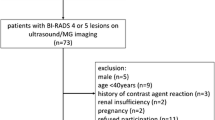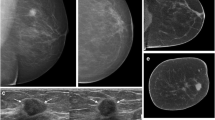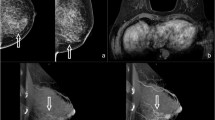Abstract
Purpose
To review the published evidence on cone-beam breast computed tomography (CBBCT) and summarize its diagnostic accuracy for breast lesion assessment.
Materials and Methods
A systematic literature search was conducted using the EMBASE, MEDLINE and CENTRAL libraries. Studies were included if reporting sensitivity and specificity for discrimination of benign and malignant breast lesions via breast CT. Sensitivity and specificity were jointly modeled using a bivariate approach calculating summary areas under the receiver-operating characteristics curve (AUC). All analyses were separately performed for non-contrast and contrast-enhanced CBBCT (NC-CBBCT, CE-CBBCT).
Results
A total of 362 studies were screened, of which 6 with 559 patients were included. All studies were conducted between 2015 and 2018 and evaluated female participants. Four of six studies included dense and very dense breasts with a high proportion of microcalcifications. For NC-CBBCT, pooled sensitivity was 0.789 (95% CI: 0.66–0.89) and pooled specificity was 0.697 (95% CI: 0.471–0.851), both showing considerable significant between-study heterogeneity (I2 = 89.4%, I2 = 94.7%, both p < 0.001). Partial AUC for NC-CBBCT was 0.817. For CE-CBBCT, pooled sensitivity was 0.899 (95% CI: 0.785–0.956) and pooled specificity was 0.788 (95% CI: 0.709–0.85), both exhibiting non-significant moderate between-study heterogeneity (I2 = 57.3%, p = 0.0527; I2 = 53.1%, p = 0.0738). Partial AUC for CE-CBBCT was 0.869.
Conclusion
The evidence available for CBBCT tends to show superior diagnostic performance for CE-CBBCT over NC-CBBCT regarding sensitivity, specificity and partial AUC. Diagnostic accuracy of CE-CBBCT was numerically comparable to that of breast MRI with meta-analyses reporting sensitivity of 0.9 and specificity of 0.72.
Key Points
• CE-CBBCT rather than NC-CBBCT should be used for assessment of breast lesions for its higher diagnostic accuracy.
• CE-CBBCT diagnostic performance was comparable to published results on breast MRI, thus qualifying CE-CBBCT as a potential imaging alternative for patients with MRI contraindications.






Similar content being viewed by others
Abbreviations
- ACR:
-
American College of Radiology
- AUC:
-
Area under the curve
- CBBCT:
-
Cone-beam breast CT
- CE-CBBCT:
-
Contrast-enhanced cone-beam breast CT
- MG:
-
Mammography
- MRI:
-
Magnetic resonance imaging
- NC-CBBCT:
-
Non-contrast cone-beam breast CT
- US:
-
Ultrasound
References
Wienbeck S, Lotz J, Fischer U (2016) Review of clinical studies and first clinical experiences with a commercially available cone-beam breast CT in Europe. Clin Imaging 42:50–59
Boss A (2018) Editorial comment: cone-beam and phase contrast CT: new horizons in breast imaging? Eur Radiol. https://doi.org/10.1007/s00330-018-5456-5
Seifert P, Conover D, Zhang Y et al (2014) Evaluation of malignant breast lesions in the diagnostic setting with cone beam breast computed tomography (Breast CT): feasibility study. Breast J 20:364–374
Zhao B, Zhang X, Cai W, Conover D, Ning R (2015) Cone beam breast CT with multiplanar and three dimensional visualization in differentiating breast masses compared with mammography. Eur J Radiol 84:48–53
He N, Wu YP, Kong Y et al (2016) The utility of breast cone-beam computed tomography, ultrasound, and digital mammography for detecting malignant breast tumors: A prospective study with 212 patients. Eur J Radiol 85:392–403
Prionas ND, Lindfors KK, Ray S et al (2010) Contrast-enhanced dedicated breast CT: initial clinical experience. Radiology 256:714–723
Uhlig J, Fischer U, Surov A, Lotz J, Wienbeck S (2018) Contrast-enhanced cone-beam breast-CT: Analysis of optimal acquisition time for discrimination of breast lesion malignancy. Eur J Radiol 99:9–16
Uhlig J, Fischer U, von Fintel E et al (2017) Contrast enhancement on cone-beam breast-CT for discrimination of breast cancer immunohistochemical subtypes. Transl Oncol 10:904–910
O'Connell AM, Kawakyu-O'Connor D (2012) Dedicated cone-beam breast computed tomography and diagnostic mammography: comparison of radiation dose, patient comfort, and qualitative review of imaging findings in BI-RADS 4 and 5 lesions. J Clin Imaging Sci 2:7
Wienbeck S, Fischer U, Luftner-Nagel S, Lotz J, Uhlig J (2018) Contrast-enhanced cone-beam breast-CT (CBBCT): clinical performance compared to mammography and MRI. Eur Radiol. https://doi.org/10.1007/s00330-018-5376-4
Wienbeck S, Lotz J, Fischer U (2017) Feasibility of vacuum-assisted breast cone-beam CT-guided biopsy and comparison with prone stereotactic biopsy. AJR Am J Roentgenol 208:1154–1162
Wienbeck S, Uhlig J, Luftner-Nagel S et al (2017) The role of cone-beam breast-CT for breast cancer detection relative to breast density. Eur Radiol 27:5185–5195
Peters NH, Borel Rinkes IH, Zuithoff NP, Mali WP, Moons KG, Peeters PH (2008) Meta-analysis of MR imaging in the diagnosis of breast lesions. Radiology 246:116–124
Cole E, Campbell A, Vedantham S, Pisano E, Karellas A (2015) Clinical performance of dedicated breast computed tomography in comparison to diagnostic digital mammography. Radiological Society of North America 2015 Scientific Assembly and Annual Meeting, November 29 - December 4, 2015, Chicago IL
Reitsma JB, Rutjes AWS, Whiting P, Vlassov VV, Leeflang MMG, Deeks JJ (2009) Chapter 9: Assessing methodological quality. In: Deeks JJ BP, Gatsonis C, (ed) Cochrane Handbook for Systematic Reviews of Diagnostic Test Accuracy Version 100. The Cochrane Collaboration
Whiting PF, Rutjes AW, Westwood ME et al (2011) QUADAS-2: a revised tool for the quality assessment of diagnostic accuracy studies. Ann Intern Med 155:529–536
Whiting PF, Weswood ME, Rutjes AW, Reitsma JB, Bossuyt PN, Kleijnen J (2006) Evaluation of QUADAS, a tool for the quality assessment of diagnostic accuracy studies. BMC Med Res Methodol 6:9–9
Hamza TH, van Houwelingen HC, Stijnen T (2008) The binomial distribution of meta-analysis was preferred to model within-study variability. J Clin Epidemiol 61:41–51
Reitsma JB, Glas AS, Rutjes AW, Scholten RJ, Bossuyt PM, Zwinderman AH (2005) Bivariate analysis of sensitivity and specificity produces informative summary measures in diagnostic reviews. J Clin Epidemiol 58:982–990
R Development Core Team (2008) R: A language and environment for statistical computing. R Foundation for Statistical Computing, https://www.r-project.org, Vienna, Austria
RStudio Team (2015) RStudio: Integrated Development for R, Boston, MA, USA, https://www.rstudio.com
Schwarzer G (2007) meta: An R package for meta-analysis. R News 7:40–45
Doebler P (2017) mada: Meta-Analysis of Diagnostic Accuracy. R package version 0.5.8. Available via https://CRAN.R-project.org/package=mada
Aminololama-Shakeri S, Abbey CK, Gazi P et al (2016) Differentiation of ductal carcinoma in-situ from benign micro-calcifications by dedicated breast computed tomography. Eur J Radiol 85:297–303
Kolb TM, Lichy J, Newhouse JH (2002) Comparison of the performance of screening mammography, physical examination, and breast US and evaluation of factors that influence them: an analysis of 27,825 patient evaluations. Radiology 225:165–175
Mandelson MT, Oestreicher N, Porter PL et al (2000) Breast density as a predictor of mammographic detection: comparison of interval- and screen-detected cancers. J Natl Cancer Inst 92:1081–1087
Bennani-Baiti B, Baltzer PA (2017) MR imaging for diagnosis of malignancy in mammographic microcalcifications: a systematic review and meta-analysis. Radiology 283:692–701
Bazzocchi M, Zuiani C, Panizza P et al (2006) Contrast-enhanced breast MRI in patients with suspicious microcalcifications on mammography: results of a multicenter trial. AJR Am J Roentgenol 186:1723–1732
Ding H, Ducote JL, Molloi S (2013) Measurement of breast tissue composition with dual energy cone-beam computed tomography: a postmortem study. Med Phys 40:061902
McGrath TA, McInnes MDF, Langer FW, Hong J, Korevaar DA, Bossuyt PMM (2017) Treatment of multiple test readers in diagnostic accuracy systematic reviews-meta-analyses of imaging studies. Eur J Radiol 93:59–64
Funding
The authors did not receive funding for work related to this manuscript.
Author information
Authors and Affiliations
Corresponding author
Ethics declarations
Guarantor
The scientific guarantor of this publication is Susanne Wienbeck.
Conflict of interest
The authors of this manuscript declare no relationships with any companies, whose products or services may be related to the subject matter of the article.
Statistics and biometry
Two authors have significant statistical expertise.
Informed consent
Written informed consent was not required for this study because it is a meta-analysis.
Ethical approval
This study was performed in accordance with the Declaration of Helsinki. Ethical committee approval was not necessary because of the meta-analysis design.
Study subjects or cohorts overlap
Parts of the study population have been previously reported as detailed in the Materials and Methods section as well as the references.
Methodology
• observational
Electronic supplementary material
ESM 1
(DOCX 14 kb)
Rights and permissions
About this article
Cite this article
Uhlig, J., Uhlig, A., Biggemann, L. et al. Diagnostic accuracy of cone-beam breast computed tomography: a systematic review and diagnostic meta-analysis. Eur Radiol 29, 1194–1202 (2019). https://doi.org/10.1007/s00330-018-5711-9
Received:
Revised:
Accepted:
Published:
Issue Date:
DOI: https://doi.org/10.1007/s00330-018-5711-9




